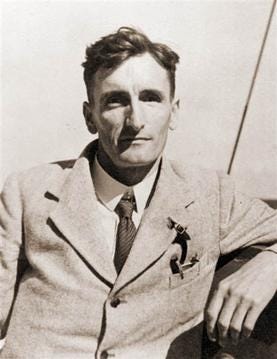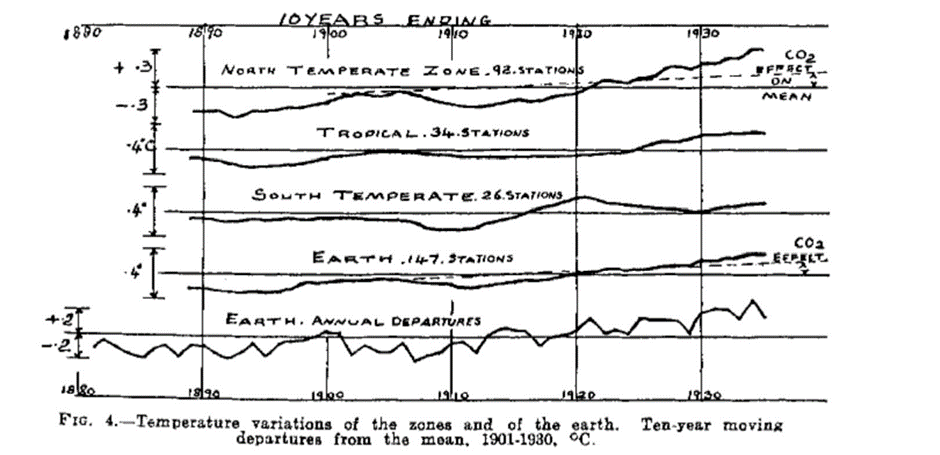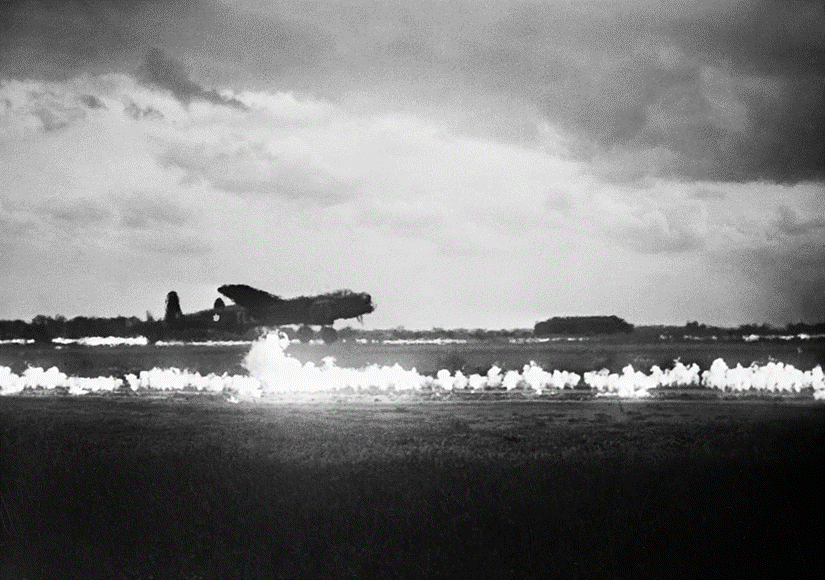Guy Stuart Callendar
Discovering the link between the artificial production of carbon dioxide and global warming.
The shadow of the First World War and the instability and insecurity of the severe economic depression of the 1930s greatly affected political developments in Europe. Economic stagnation gave rise to political extremism and led people to look to authoritarian parties as a political alternative. Authoritarian regimes became established in many European countries at the time. The fascist Benito Mussolini come to power in Italy in 1922 and Adolf Hitler became Chancellor in 1933, establishing a totalitarian one-party state under the Nazis.
Hitler’s expansionist policies became increasingly clear in 1938. On the morning of 12 March 1938, German troops invaded Austria and, without the spilling of blood, incorporated Austria into the German Reich, in what is known as Anschluss. There was little or no opposition from the Austrian population or international condemnation of Austria’s annexation. A few months later, on September 1938, Hitler invaded Czechoslovakia to ‘help’ Germans in the Sudetenland, an area in former Czechoslovakia which was inhabited primarily by Sudeten Germans. Again, there was little condemnation by the European countries. Instead, after meeting with Hitler in Berghof, the British Prime Minister, Neville Chamberlain agreed that Czechoslovakia should give all areas with 50 percent German Sudeten to Germany. On 29 September 1938, the Italian, German, British and French leaders met in Munich and agreed to accept the German annexation of the Sudetenland. the Czechs were left with no other option but to agree. The British policy of accepting German expansion in Europe in the 1930s is called appeasement. The rest, as they say, is history.
While Europe was teetering on the edge of the war, an English steam and combustion engineer and amateur meteorologist, published a paper in the Quarterly Journal of the Royal Meteorological Society. His name was Guy Stuart Callendar and his paper, titled “The artificial Production of Carbon Dioxide and its Influence on Temperature”, was going to be one of the most influential papers on climate change science. The link between the artificial production of carbon dioxide – that is, increases in the concentration of atmospheric carbon dioxide due to human activities, primarily through burning fossil fuels – and global warming was a monumental discovery. Today it is called the “Callendar Effect.”
Early Life
Guy Stewart Callendar (1898-1964) was the son of Hugh Longbourne Callendar, a British physicist known for his contributions to thermometry and the thermodynamic properties of steam and Victoria Mary Stewart. He was born on 9 February 1898, in Montreal, Canada, where his father was appointed professor of physics at McGill University. His two older siblings, Cecil and Leslie Hugh, were also born in Montreal. Before Guy’s first birthday, the family returned to England, his father having been offered the prestigious Quain Chair of Physics at University College, London. In 1902, H. L. Callendar accepted a professorship of physics at the Royal College of Science, which became part of Imperial College in 1907.
An inquisitive scientist and motorist enthusiast, Hugh Callendar was keenly interested in engines and their power source, and a great influence on Guy Stewart Callendar and his siblings. From 1909 to 1913, Guy Callendar attended Durston House School, a small and elite private school in Ealing. In 1913 he entered as a day student at the exclusive St. Paul’s School in Hammersmith, a traditional school that emphasised the study of Greek, Latin, and the humanities, but he left two years later, in 1915, in part because he detested the school’s evident militarism.
The loss of his left eye in a childhood accident rendered Callendar unsuitable for frontline service in the First World War. But this didn’t stop him from making valuable technical contributions to the war effort. For two years, he worked in his father’s laboratory at Imperial College as an assistant to the X-ray Committee of the Air Ministry testing a variety of apparatus, including aircraft engines at the Royal Aircraft Factory (later Establishment) in Farnborough. Later, he enlisted in the Royal Naval Volunteer Reserves attaining the rank of sub-lieutenant. He served as a hydrophones officer and gained experience with electrical apparatus developed by his father to detect low-frequency sounds generated by submarines.
The Steam Years
Guy Stuart Callendar. By Wikipedia http://www.aip.org/history/climate/xGSCallendar.htm, Fair use, https://en.wikipedia.org/w/index.php?curid=16897189
In 1919 Guy Callendar entered City and Guilds College, one of the founding constituent colleges of Imperial College. He earned a certificate n Mechanics and Mathematics in 1922 and for the next eight years, he worked as a researcher in his father’s laboratory, assisting him with problems of steam engineering. In 1926, with his father, he co-authored his first scientific article on the total heat of steam. During these years, he also developed his interest in meteorology. In his detailed account of Guy Stewart Callendar, James R. Fleming writes:
“Guy’s interest in meteorology also received a boost from his father’s inventions related to the atmosphere: a sunshine receiver that accurately measured and recorded total solar radiation, an electrical air temperature grid to measure and record variations in atmospheric temperature, an absolute recording bolometer, a thermopile to measure the radiation from the sun’s corona, and a disc radio-balance to measure the amount of radiation emitted by the sun or other strong sources.”
The Callendar Effect
On 30 August 1930, Guy Callendar married Phyllis Burdon Pentreath, and eventually, in 1942, they settled in Horsham with their two daughters.
Callendar had already been spending his spare time gathering temperature data and weather data from around the world, which he recorded in his daily weather diary. Perhaps because of his engineering training, his measurements were so accurate that “they were used to correct the official temperature records of central England”.
By using records from 147 weather stations around the world and by making all the calculations by hand while working alone at his home, Callendar estimated that between 1880 and the early 1930s humans had added to the atmosphere about 150,000 million tonnes of carbon dioxide which was corresponded to an increase in temperature “at the rate of 0.003 degrees Celsius per year during the half past century.” In order to represent the temperature anomalies of the earth’s surface, Callendar “grouped a number of stations together and then weighted each group according to the area represented by its stations. (Figure 4).
He writes:
“From the curves in Fig. 4, it will be seen that the greater part of the warmth of recent years has occurred in the northern regions; these, with the exception of the west Pacific stations, all show a decided rising tendency since about 1920. In tropical regions departures are more local and variable but each of the three groups used (Indian Ocean, Tropical Atlantic and Tropical west Pacific show a distinctly higher mean temperature for the 25 years, 1910-1934, than for the previous 25 years.” (Callendar, The artificial production of carbon dioxide and its influence on temperature, 1938, pp. 223-234)
In his paper, Callendar also examined several factors that influence the carbon cycle in nature, such as the organic deposits of carbon in swamps, and “the effect of solution of the gas by the seawater.” He implied that the oceans act as a “giant regulator of carbon dioxide and holds some sixty times as much as the atmosphere”. Recent studies show that the ocean absorbs just under one-third of anthropogenic CO2 emissions, but with a cost. When CO2 dissolves in seawater, it forms carbonic acid and as more CO2 is taken up by the ocean’s surface, the pH decreases, moving towards a less alkaline and therefore more acidic state, making it more difficult for organisms like oysters and corals to build shells. It is called ocean acidification.)
Callendar also recognised that “… Few of those familiar with the natural heat exchanges of the atmosphere which go into the making of our climates and weather would be prepared to admit that the activities of man could have any influence upon phenomena of so vast a scale” … yet he hoped “to show that such influence is not only possible but is actually occurring at the present time.”
As Svante Arrhenius before him, Callendar concluded his paper speculating that the combustion of fossil fuels “is likely to prove beneficial to mankind in several ways, besides the provision of heat and power. For instance, the above mentioned small increases of mean temperature would be important at the northern margin of cultivation, and the growth of favourably situated plants is directly proportional to the carbon dioxide pressure. In any case, the return of the deadly glaciers should be delayed indefinitely.”
Of course, the view that warm is good and cold is bad was the norm for centuries and an ice age is less likely today. Callendar either thought that the negatives of a warming planet - sea level rise, heatwaves, storms, floods, and wildfires – would be detrimental, or he didn’t think at all about it.
Callendar published his discoveries in a series of papers, but they did not raise any interest from the scientific community at the time. Only, later, in 1957, just before the beginning of the International Geophysical Year (IGY), Hans Seuss and Roger Revelle referred to the "Callendar effect," defining it as “climatic change brought about by anthropogenic increases in the concentration of atmospheric carbon dioxide, primarily through the processes of combustion.”
The War Years
During World War II, Guy Callendar was assigned to defense work at Langhurst a secret research facility located in a country mansion in West Sussex, where he participated in research and development for the Petroleum Warfare Department and the Ministry of Supply. He was involved in the project FIDO (Fog Investigation and Dispersal Operation), a system that cleared fogbound airports. FIDO - one of Britain’s important secret weapons - saved thousands of pilots’ lives by bringing Allied planes in safely in zero-zero weather, that is when atmospheric conditions reduced ceiling and visibility to zero. Fido’s burners, alongside runways, threw out flaming gasoline that ate holes in the fog. The glow of the burners could be seen from a hundred kilometers away.
FIDO (Fog Investigation Dispersal Operations) petrol burners are ignited on either side of the main runway at Graveley, Huntingdonshire, as an Avro Lancaster of No. 35 Squadron RAF takes off in deteriorating weather, 28 May 1945. Royal Air Force official photographer, Goochild A (Flt Lt), Public domain, via Wikimedia Commons
Callendar was a key engineer in FIDO and his work was classified “top secret.” He could not discuss the details with anyone outside the lab, including his family. Perhaps because of his work in FIDO, Callendar also conducted research on the efficiency of fuel cells and on the infrared spectrum, which allowed him to study further the role of carbon dioxide and water vapour in the earth-atmosphere system.
Following the war, Callendar continued to write and publish about climate. In 1949 he published a popular article, titled Can Carbon Dioxide Influence Climate?, where he reported a “more rapid increase of carbon dioxide than that of fuel alone.” Among the other man’s activities that release carbon dioxide in the atmosphere he includes deforestation, and changes in land conditions. Still, he was not particularly worried. “There is,” he writes, “no need for alarm at the possibility of the air becoming contaminated by too much carbon dioxide, because the waters of the oceans provide a reservoir of almost infinite capacity to absorb excess. Of course, we now know that the ocean is the greatest of the carbon reservoirs, but its capacity to absorb carbon dioxide is not infinite and quantifying the absorb carbon is still a complex problem that requires measurements and observations from a range of sources including ships, buoys and satellites. The carbon, however, requires centuries to penetrate into the deep ocean, because the mixing of the oceans is a slow process. In geological time this is rather fast, but from a human respective it is very slow to extensively buffer climate change.
Callendar concludes his article.
“In conclusion, it may be said that the climates of the world are behaving in a manner which suggests that slightly more solar heat is being retained in the atmosphere. This could be due to its increasing opacity to terrestrial heat as a result of the additions of carbon dioxide. But the coincidence by itself is no proof because we do not know if the solar heat has remained constant over the period; it does, however, provide an intriguing example where the expected happens on the grand scale.”
Bibliography:
Callendar, G. (1938). The artificial production of carbon dioxide and its influence on temperature,. Quartely Journal of Royal Meteorological Society. doi:https://doi.org/10.1002/qj.49706427503
Nicolas Gruber, e. al. (2019). The oceanic sink for anthropogenic CO2 from 1994 to 2007 (Vols. Vol 363, Issue 6432). Science. doi:https://www.science.org/doi/10.1126/science.aau5153
Callendar, G. (1949, October ). Can Carbon Dioxide Influence Climate? Weather, 4(10), 310-314. doi:https://doi.org/10.1002/j.1477-8696.1949.tb00952.x
Fleming, J. R. (2003). What Role Did G.S. Callendar Play in Reviving the CO2 Theory of Global Climate Change? Presidential Symposium on History of Meteorology, American Meteorological Society. Long Beach .
Fleming, J. R. (2007). The Callendar Effect: The Life and Work of Guy Stewart Callendar (1898-1964). oston American Meteorological Society .






